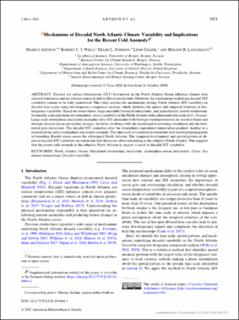Mechanisms of decadal North Atlantic climate variability and implications for the recent cold anomaly
Journal article, Peer reviewed
Published version

Åpne
Permanent lenke
https://hdl.handle.net/11250/2838941Utgivelsesdato
2021Metadata
Vis full innførselSamlinger
- Geophysical Institute [1187]
- Registrations from Cristin [9489]
Sammendrag
Decadal sea surface temperature (SST) fluctuations in the North Atlantic Ocean influence climate over adjacent land areas and are a major source of skill in climate predictions. However, the mechanisms underlying decadal SST variability remain to be fully understood. This study isolates the mechanisms driving North Atlantic SST variability on decadal time scales using low-frequency component analysis, which identifies the spatial and temporal structure of low-frequency variability. Based on observations, large ensemble historical simulations, and preindustrial control simulations, we identify a decadal mode of atmosphere–ocean variability in the North Atlantic with a dominant time scale of 13–18 years. Large-scale atmospheric circulation anomalies drive SST anomalies both through contemporaneous air–sea heat fluxes and through delayed ocean circulation changes, the latter involving both the meridional overturning circulation and the horizontal gyre circulation. The decadal SST anomalies alter the atmospheric meridional temperature gradient, leading to a reversal of the initial atmospheric circulation anomaly. The time scale of variability is consistent with westward propagation of baroclinic Rossby waves across the subtropical North Atlantic. The temporal development and spatial pattern of observed decadal SST variability are consistent with the recent observed cooling in the subpolar North Atlantic. This suggests that the recent cold anomaly in the subpolar North Atlantic is, in part, a result of decadal SST variability.
